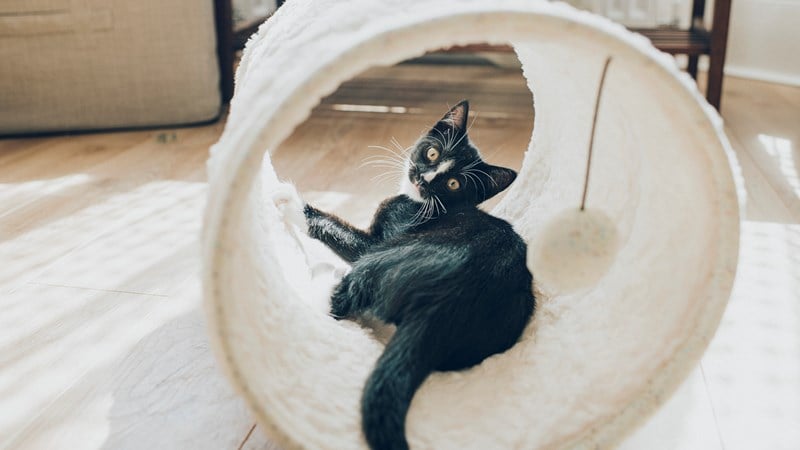
Introducing Kittens To Dogs
Read our top tips
Dogs will often accept a new kitten more easily than cats will and many dogs and cats go on to become really good friends. You’ll still need to supervise all early interactions and it’s important to prepare your dog and to recognise that some dogs are more likely to show predatory behaviour to a kitten, so safety is a priority.
Read more...
Some dogs have been bred to show a high predatory drive. This means that small or fast-moving animals will make them feel a strong urge to chase and catch. Sighthounds and terriers can show this kind of tendency in particular, because they were bred to catch prey. Your dog may already know about cats and you might have an idea of how they are likely to feel about a kitten.
All dogs have the potential to hurt a kitten so, before allowing face-to-face introductions, you’ll need to backtrack a few steps and introduce something called ‘impulse control’. This means helping your dog to be calm in exciting situations, rather than reacting immediately to them.
Allow your dog to acknowledge something they find interesting or exciting (such as another animal, or someone playing with a ball) and reward them immediately when they choose to look away from the interesting subject. You can move on to teaching your dog impulse control when they can see your kitten on the other side of a stair gate, or if your kitten is safely in a puppy crate so they can’t approach your dog.
During this part of the introduction process, keep your dog on their lead so they can’t rush towards your kitten and frighten them, especially if you’re using a puppy crate to keep your kitten safe. Have enough distance between your dog and your kitten that your kitten doesn’t look frightened.
Kittens are often quite inquisitive, and many are much less likely to run away from a dog who is behaving calmly. This in itself should make your dog less likely to want to chase, as a dog’s predatory drive is triggered by a prey animal running away.
Once your dog is relaxed and calm when seeing your kitten across a stairgate or in a crate, and you can keep their attention for a short time when they can see your kitten, you can allow them to interact more freely.
Put your dog’s lead on and make sure that your kitten has places they can climb onto or hide inside if they want to get away. Take your dog into the kitten’s room. Focus on your dog, giving them lots of praise and attention when they behave calmly and just let your kitten come and investigate. Some dogs will react aggressively towards a kitten if you are holding high-value treats or a favourite toy as rewards and the kitten comes to have a look, so consider your dog’s personality and how much they value treats and toys – you may be better without them for this step.
When your dog is comfortable with your kitten wandering around nearby, you can move on to holding your kitten in your lap and allowing your dog to inspect them. You’ll need a helper – one person to cuddle the kitten and another to hold your dog’s lead while they have a look at the kitten. As long as the kitten isn’t trying to hide, or scrabbling to escape, and your dog is being calm and not becoming more excited, they can have a few moments at a time to interact.
Reward your dog for good impulse control. Keep these sessions very short – ideally, you want to lead your dog away while they are still calm. If your dog shows signs of becoming excited, by stiffening, pulling on the lead or beginning to whine, walk them away and reward them for doing so quietly, then try again later.
After a while, you should be able to allow your dog and kitten to be in the same room under supervision but without being held. If your dog knows how to lie down or settle, bring them into the kitten’s room and let them do so while your kitten is wandering around freely. Reward your dog for calm behaviour. It’s still a good idea to have a lead attached to your dog’s collar or harness, just in case you need to intervene.
Once both pets are comfortable with this level of interaction, you should be able to allow them the freedom of more rooms under supervision. Separate them whenever you can’t be there to keep an eye on them, until you’re sure they are happy together. If you leave food down for your dog, beware that they may not appreciate your kitten investigating it. Also, dog kibble may be a choking hazard to a kitten, so be mindful of this.
Dogs often like cat food and some also like investigating litter trays, so keep cat food and litter trays out of your dog’s reach.
Many dogs and cats become very bonded – in fact, some cats prefer canine companions to feline friends!
Health Plans to keep your kitten healthy
At Vets4Pets we offer a range of Health Plans that make essential routine treatments more affordable. You'll save money on things like annual vaccinations, flea and worm treatment and routine health check-ups.

Join our free Kitten club
Join the club for expert advice and tailored offers, including £30 off our Complete Care Health Plans

Puppy & Kitten Advice
Giving your pet the best start in life begins with getting the best expert advice.
